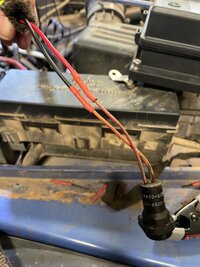unplugged the TCC, no blown fuse no smoke. Plugged TCC back in upside down, no blown fuse no smoke. Also can hear the fuel pump kick on, so something with the TCC is definitely causing a lot of strife, but it seems that I can at least work around it for the time being. Can't test the gauges or OBDII with the dash out, but I'm willing to bet I have fixed that as well.
I need to really analyze the TCC circuit, because I'm not convinced it should matter how it's wired. Or rather, I don't (yet) understand why it matters how it's wired, and I'm not (yet) convinced I did it wrong despite the symptoms. At their core, solenoids aren't directional, so something else is making the polarity important. I have a new solenoid on hand, and there are two leads coming off it and they're both identical so it's only 50/50 you would wire it in the right way, meaning you would only have a 50/50 of plugging the external plug in correctly. That can't be how this works. But on the other hand it's the only connector I'm aware of that will fit in multiple orientations, so maybe???
TCC circuit analysis
Here is what the path looks like from the factory:
fuse #11 ==> 20ga
RD/
LG wire ==> TCC solenoid ==> 18ga
OR/
LG wire ==> PCM cavity B11
The
RD/
LG wire is the "Fused Ignition Switch Output (Run/Start) which means that the Red/Light Green wire has 12V on it when the key is ON. When the PCM decides to lock up the torque converter, it does so by providing a ground on the
OR/
LG wire. So the nominal state is that the
OR/
LG wire is
not grounded? That makes sense: the circuit is essentially always open/incomplete until the PCM provides ground, which is why unplugged doesn't make the thing lock up & stall/prevent starting.
Of course I found my OR/LG wire cut near the PCM plug with a new black wire spliced in at the connector, so what I should actually have is:
fuse #11 ==>
RD/
LG wire ==> TCC plug cavity A
==> {the actual solenoid} ==>
TCC Plug cavity B==>
OR/
LG wire ==> new black wire ==> stub of
OR/
LG ==> PCM
And because I had to splice in a new TCC plug I needed to add in some new wire. I took a pic of this and have verified these splices. Although maybe there is more to this story since the pictured red splice is clearly not an 18ga wire...it might be a relic of my temporary fix in this area over the summer; that could be a red 14ga, which would mean there is one more splice further up in that insulation. I seriously doubt I would've done all this work and left an unnecessary splice but maybe I thought I needed the length? I'll have to verify that this afternoon. I guess I can also test for voltage with the key on, that will tell me how I have it wired upstream. I need to make a new year's resolution to use my voltmeter more.

At any rate this is how I believe it is currently wired:
fuse #11 ==>
RD/
LG wire ==>
Red splice ==>
RD/
LG wire ==> TCC plug cavity A
==> {the actual solenoid} ==>
TCC plug cavity B ==>
OR/
LG wire ==> new black wire ==> stub of
OR/
LG ==> PCM
As far as I can tell, I have this wired up correctly. So we're back to this basic symptom: if I plug the TCC in one way, it blows the fuse and I get no fuel pump (among other things). If I plug it in the other way everything seems to work & the jeep will start. Maybe I should flip it back and make sure the fuse blows again, and do my best to not allow the harness to move, which would prove that the issue is in there. I'm assuming a short, but if there is a short it shouldn't matter if A is touching B or if B is touching A. Coulomb, Maxwell, and Kirchoff don't care.
Ok, I should probably do my actual job for a few hours and stop obsessing over this.


